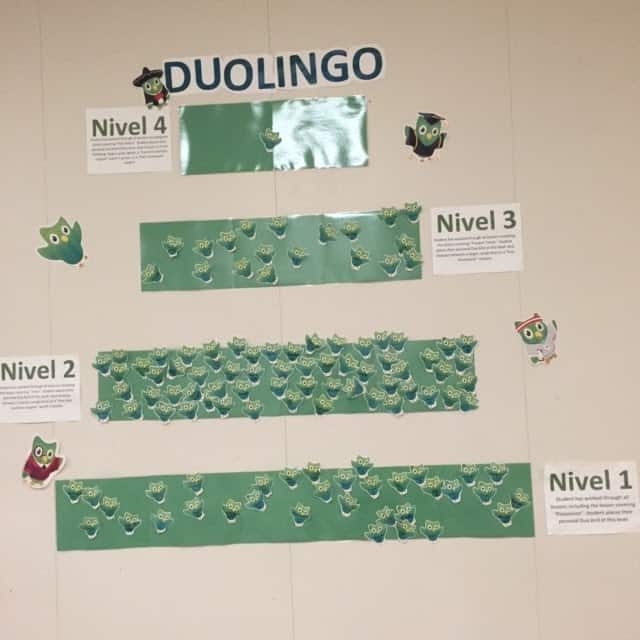Could Online Learning Tools Replace the Traditional Teacher?

In the age of 21st century schools, flipped classrooms and cyber education, a question for the need of a traditional teacher may actually be at hand. As a language teacher, I always considered job security a sure thing. Sure, a student can read grammatical rules and memorize vocabulary cards, but true explanation of a language is a necessity, right?
Now that so many online language tools are accessible worldwide, what is the future of the classroom teacher? As a user myself, when I first considered the idea of introducing an edtech tool to my high-school students, I was curious not only if it would fit into the curriculum, but if it could potentially replace me in the end. After all, the tool I chose (Duolingo for Schools) works with the same vocabulary, the same grammar and is highly stimulating to the current technology-obsessed generation.
The Experiment
Despite the career implications, I figured a supplemental app could still help my students, and maybe capture the interests of a few more of the less engaged students. With that in mind, I decided to give it a go. After several days of introducing the students to the new software (distributing district emails, creating usernames and selling the game to 200 rambunctious teenagers), the experiment began.
 I found that the graphics and game-like reward system kept users both motivated and entertained as they worked through a research based curriculum. I created my own reward system choosing various lessons on the curriculum pyramid, designated different prizes for each level reached and made an eye-catching visual for students to watch their own personal progress. The race to the top of the pyramid commenced!
I found that the graphics and game-like reward system kept users both motivated and entertained as they worked through a research based curriculum. I created my own reward system choosing various lessons on the curriculum pyramid, designated different prizes for each level reached and made an eye-catching visual for students to watch their own personal progress. The race to the top of the pyramid commenced!
Observations
First, let me just say as a teacher of a crowded (and at times disruptive) urban classroom, I began to experience something fairly unusual–silence. The students appeared enthralled by the colors, the images and the immediate affirmation that the app’s beeps and dings provided.
I was thrown. Once a week I was witnessing a classroom with at least 90% full engagement where the primary words spoken were, “I just leveled up!” or “It told me I am 10% fluent!” Already, I was witnessing a brand new enthusiasm for language learning. Could this be the foreign language classroom of the future?!
Engagement, however, is not the only measure of an effective teaching environment. After a month, I began to witness another interesting difference. I decided to try something that I hadn’t in previous years. I included verbs conjugated in the present tense as part of a vocabulary game prior to formally introducing the concept.
It is well known that conjugation is one of the most difficult concepts to teach. The equivalent in English is not entirely comparable and the students often do not understand that the ending of a verb is imperative to it’s meaning. I did not give my students any special instructions; I just included the verbs and watched to see what happened–and I was blown away.
As the kids picked various words from their brown bags of vocabulary, they were effectively identifying not only what the verb meant, but who was doing the verb. For example, a student picked the verb bailo. She identified it:“Hmm, I dance?” Another student picked descansamos, and he immediately responded: “That is we relax, right?”
I couldn’t believe it. My students were interpreting conjugated verbs well before I even introduced the idea in class. This was a breakthrough. Again, does this school even need me any longer?!
As the months passed, my student’s interest waxed and waned toward using the app. Some days they were thrilled to work alone at their own pace, generally picking up one or two new vocabulary words during each session and absorbing pieces of grammar without realizing it. Other days, they preferred Facebook and a nap. Regardless, the effects of Duolingo continued.
The Results
The overall success of the new software was overwhelming. These students could do things far better than my students the year prior, but I still wondered: could they be performing this well without me? My students’ conjugation recognition breakthrough was real, but they still struggled to conjugate verbs on their own. It wasn’t until I presented lengthy descriptions behind the logic of conjugation and various activities of verbal and written practice that most of the students finally understood. Maybe they still needed me after all?
There were other examples where formal instruction was necessary as well. Vocabulary only truly stuck after lengthy practice and application. Listening practice via Duolingo was also limited. Additional activities in class with native speakers really pushed the students past their comfort level into higher levels of proficiency.
Their writing and reading abilities, though influenced by the constant contact on their computer screens, were developed with in-class graphic organizers, extensive practice with authentic articles and long sessions of revision and rewrites. These were all things that an app wasn’t quite able to do as well as a teacher could. Again, I gave myself a little credit.
The Conclusion
My professional conclusion was this: after four months of weekly use of Duolingo, my students excelled much further than students of previous years. My work with the classes, however, was vital in allowing them to push past their Zone of Proximal Development and truly be able to apply the information they were encountering via Duolingo.
Ultimately, the app served as the perfect supplementary tool. It not only gave me the freedom of a quiet and engaged classroom once a week, but it gave my students much needed exposure to additional vocabulary and grammar structures in a different setting in an immediately rewarding environment.
For now, this harmony can only enrich the present day foreign language classroom. Without the fear of being replaced, teachers should consider this effective resource as additional exposure to their target language and potentially the much-needed tool to capture the interest of even the most jaded teenager–a challenge we all know is real.
For more, see:
- 10 Popular Apps for English Language Learners and Teachers
- How to Utilize a Makerspace for World Language Learning
- 7 Best Listening Resources for Language Learners
Stay in-the-know with all things EdTech and innovations in learning by signing up to receive the weekly Smart Update.







Ed Jones
What do you think would change if it were 2 days a week?
Nathan Riley
Well done! Great idea utilizing an app to complement in-classroom teaching. I think this is ultimately the way things are heading, especially considering how easily distracted kids (and adults for that matter) are by their mobile devices.
Todd Kominiak
It's pretty clear: technology definitely can enhance the student experience in the classroom, but not without the guidance of good teachers.
Jo Quinton
I too have use Duolingo with students, albeit in very small numbers but have also noticed a deeper grasping of grammar, not just vocab acquisition. I find the frequent repetition in the app so essential to success, although some phrases used are a bit odd.
Rosalba La Rosa
I think it sounds great to be able to have them engaged so fully by this activity. However, we were thinking of asking our students to put away their devices when they come to class because they are more connected to Social Media than anything else! How would you deal with this very big problem in today's classrooms? Thank you for your response at your convenience.
Sincerely
Rosalba La Rosa, Spanish Instructor
LPHS, LP, Mi
Emily Riley
Thank you for the comments. Very interesting to hear feedback and suggestions. Sorry for late response! Ed- I am currently wondering the same thing. Another teacher in my department experimented with just that. Instead of doing Duolingo for an entire class period once a week, he allowed them to do it for 15 minutes twice a week. Though I appreciate the routine that this establishes, I think the more teacher/student interaction in the classroom the better. Rosalba- Yes! A huge problem that teachers of years past never had, right? For my class, I have lenient but clear rules concerning phones. For Duolingo in class we have a department wide set of laptops that my students use, so their cell phones are actually kept away. However! I have actually spent class time showing the kids how to get the app on their phones so they can do the work anywhere and everywhere. Talk about using technology to our advantage! I have seen many of my students using Duolingo in the cafeteria and often their progress (which you can track quite easily) shows they are using the program outside of school. Ultimately, a part of our jobs is to make life long learners. Phones are part of their lives, so this sort of technology may actually bridge a very important gap. I wouldn't fight the phones, we have enough battles every day. Inside embrace the idea that the majority have instant access to the Internet and show them these apps can be as much fun, if not more, than Snapchat.
Thanks for the questions!
Emily
Nágila Rabelo Moraes
Great ideas!!!